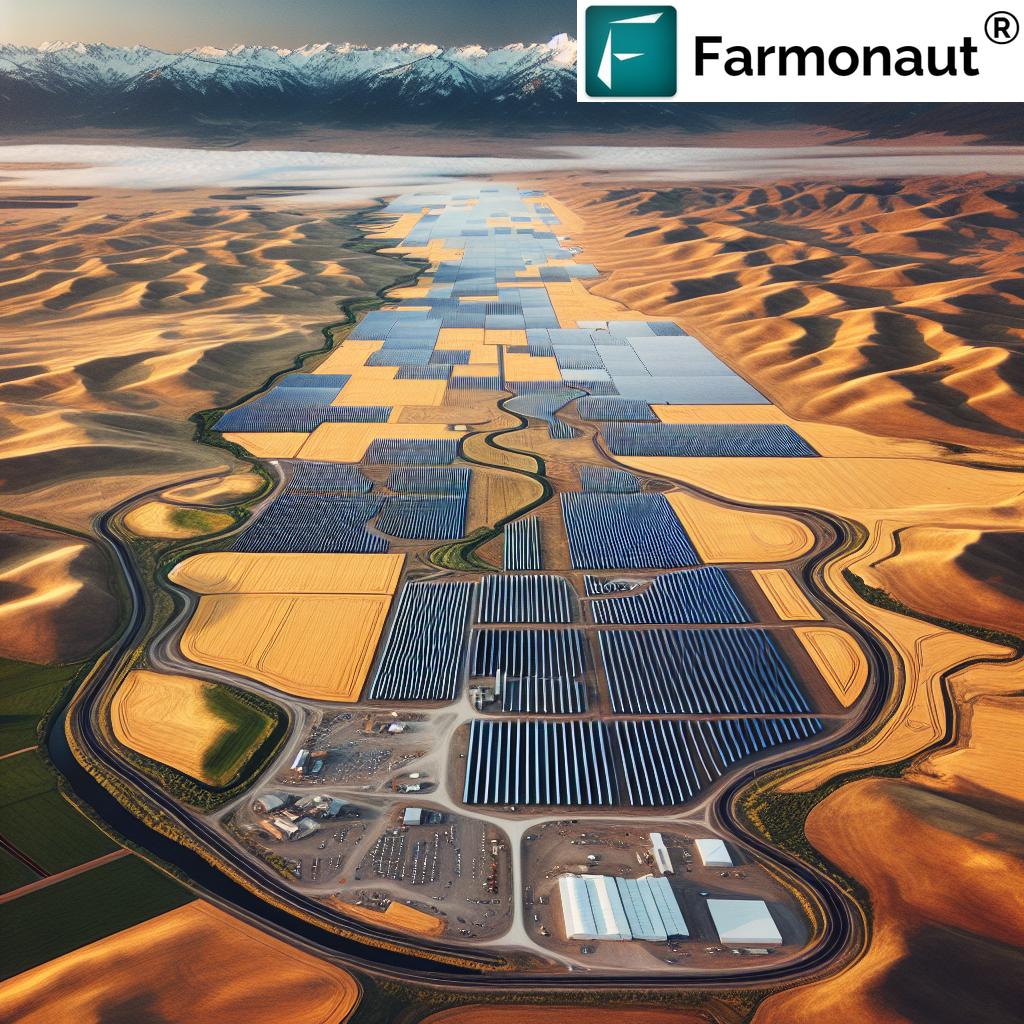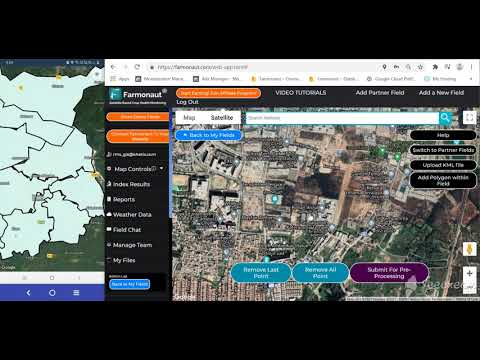Balancing Solar Energy and Rural Life: Idaho’s Evolving Zoning Ordinances for Sustainable Development
“Ada County, Idaho is revising solar farm zoning ordinances to address concerns about prime agricultural land and wildlife impact.”
As we delve into the complex world of rural development and renewable energy, we find ourselves at the crossroads of progress and preservation in Ada County, Idaho. This vast expanse of land, stretching over 1,000 square miles, is home to acres of farming and desert landscapes that have long defined the region’s character. However, the increasing demand for solar power in Idaho has sparked a crucial dialogue about how to balance the need for clean energy with the preservation of rural lifestyles and valuable agricultural resources.

In this comprehensive exploration, we’ll examine the evolving landscape of solar farm zoning ordinances in Ada County and how these changes are shaping the future of sustainable development in the region. We’ll discuss the challenges faced by county officials, the concerns of local residents, and the innovative solutions being proposed to create a harmonious coexistence between solar energy production and rural preservation.
The Rise of Solar Energy in Idaho
Idaho’s abundant sunshine and vast open spaces make it an ideal location for solar energy development. As the state’s population grows and the demand for clean energy increases, we’ve seen a significant uptick in industrial solar applications. This surge in interest has brought both opportunities and challenges to Ada County, prompting officials to reassess and modernize their approach to zoning and land use regulations.
The need for updated county zoning regulations has become increasingly apparent as more developers seek to establish large-scale solar farms in the area. These projects promise to contribute to Idaho’s renewable energy goals and provide economic benefits. However, they also raise important questions about land use, environmental impact, and the preservation of rural communities.
Current Challenges in Solar Farm Development
As we examine the current landscape of solar farm development in Ada County, several key challenges emerge:
- Preservation of Prime Agricultural Land: One of the primary concerns is the potential loss of valuable farmland to solar installations. Residents and agricultural advocates worry that prime agricultural ground could be permanently altered or removed from production.
- Wildlife Impact: The installation of large solar arrays can disrupt local ecosystems and wildlife habitats. There’s a growing need for comprehensive wildlife impact mitigation measures to ensure the protection of native species.
- Rural Lifestyle Preservation: Many residents have chosen to live in Ada County for its peaceful, rural atmosphere. The introduction of industrial-scale solar farms could potentially alter the character of these communities.
- Lack of Comprehensive Standards: The current zoning ordinances lack specific guidelines for solar farm development, leading to uncertainty for both developers and residents.
To address these challenges, Ada County officials are working diligently to revise and update the zoning ordinances, with a focus on creating a balanced approach that considers both energy production needs and community interests.
Proposed Changes to Zoning Ordinances
The proposed changes to Ada County’s zoning ordinances aim to create a comprehensive framework for renewable energy projects that addresses the concerns of all stakeholders. Some of the key areas being addressed include:
- Decommissioning Plans: Developers will be required to provide detailed plans for how they will decommission solar farm sites at the end of their operational life, ensuring that the land can be restored to its original state.
- Security and Fire Safety: New standards will be implemented to address security concerns and fire safety measures specific to solar installations.
- Wildlife and Plant Species Protection: Stricter requirements for mitigating impacts on sensitive wildlife and plant species will be incorporated into the ordinances.
- Land Use Definitions: Clearer and more precise definitions of land use terms will be established to reduce ambiguity and potential conflicts.
These proposed changes reflect a thoughtful approach to balancing energy needs and community concerns, setting the stage for sustainable development that respects both the environment and rural lifestyles.
Community Engagement and Feedback
The process of updating zoning ordinances in Ada County has been marked by significant community engagement. Residents like Debbie Davis and Dustin Ferdinand have been actively involved in the discussions, emphasizing the importance of preserving rural lifestyles and carefully defining land use terms.
Davis notes, “We want to work together with Idaho Power and everybody in the cities and counties because we know we need to find places for these resources. We just have to be smart and can’t compromise a community.”
This level of community involvement underscores the importance of a collaborative approach to developing solar farm zoning ordinances. By incorporating feedback from residents, developers, and environmental experts, Ada County aims to create regulations that truly reflect the needs and values of the community.
Balancing Act: Energy Production and Rural Preservation
At the heart of this issue lies the delicate balance between meeting growing energy demands and preserving the rural character that makes Ada County unique. As Richard Beck from the county’s Development Services points out, “It’s the people’s ordinance, it’s their law, their standards, so we want to try to find a balance that considers all voices.”
This balance involves several key considerations:
- Strategic Land Use Planning: Identifying areas suitable for solar development that minimize impact on prime agricultural land and sensitive ecosystems.
- Technological Innovation: Encouraging the use of advanced solar technologies that maximize energy production while minimizing land use.
- Community Benefits: Exploring ways in which solar projects can provide direct benefits to local communities, such as reduced energy costs or funding for community projects.
- Agricultural Integration: Investigating possibilities for dual-use solar installations that allow for continued agricultural activities alongside energy production.

“Idaho’s growing demand for solar power is prompting counties to balance energy production needs with rural lifestyle preservation.”
The Role of Technology in Sustainable Solar Development
As we navigate the complexities of integrating solar farms into rural landscapes, technology plays a crucial role in finding innovative solutions. Advanced mapping and monitoring tools, such as those provided by Farmonaut, can assist in the planning and management of solar installations while minimizing environmental impact.
Farmonaut’s satellite-based farm management solutions offer valuable insights for both agricultural and solar development planning. By leveraging real-time crop health monitoring and AI-based advisory systems, stakeholders can make informed decisions about land use that balance energy production with agricultural preservation.
For instance, Farmonaut’s technology can help identify:
- Optimal locations for solar installations that minimize impact on productive farmland
- Opportunities for dual-use solar projects that integrate agriculture and energy production
- Potential environmental impacts and mitigation strategies for proposed solar farm sites
By incorporating such advanced technologies into the planning process, Ada County can ensure that solar farm development aligns with sustainable land use practices and environmental conservation goals.
Comparative Analysis of Zoning Ordinance Impacts
To better understand the implications of the proposed changes to Ada County’s zoning ordinances, let’s examine a comparison of current and proposed regulations:
| Zoning Aspect | Current Ordinance | Proposed Changes |
|---|---|---|
| Minimum Acreage Requirements | No specific requirement | Minimum 20 acres for industrial solar farms |
| Setbacks from Residential Areas | 100 feet | 300 feet with additional landscaping buffer |
| Wildlife Impact Mitigation Measures | Limited requirements | Comprehensive wildlife survey and mitigation plan required |
| Farmland Preservation Provisions | No specific provisions | Prioritization of non-prime agricultural land for solar development |
| Decommissioning Plan Requirements | Basic outline required | Detailed plan with financial guarantees and site restoration commitments |
This comparison highlights the significant strides Ada County is making towards more comprehensive and balanced solar farm regulations. The proposed changes address many of the concerns raised by residents and environmental advocates, while still providing opportunities for renewable energy development.
The Future of Solar Energy in Rural Idaho
As Ada County moves forward with updating its zoning ordinances, the future of solar energy in rural Idaho looks promising. By carefully balancing the needs of energy production with the preservation of rural lifestyles and agricultural resources, the county is setting a precedent for sustainable development that could serve as a model for other rural communities across the United States.
Key aspects of this future include:
- Smart Growth: Targeted solar development in areas that minimize impact on prime agricultural land and rural communities.
- Innovative Technologies: Adoption of cutting-edge solar technologies that maximize energy production while minimizing land use.
- Community Partnerships: Collaborative efforts between developers, residents, and local governments to ensure mutual benefits from solar projects.
- Environmental Stewardship: Rigorous standards for wildlife protection and habitat preservation in solar farm development.
The Role of Data-Driven Decision Making
In the evolving landscape of solar farm development and rural preservation, data-driven decision-making is becoming increasingly crucial. Tools like Farmonaut’s satellite and weather API can provide valuable insights for policymakers, developers, and community members alike. By leveraging accurate, real-time data on land use, crop health, and environmental conditions, stakeholders can make more informed decisions about solar farm placement and design.
For developers and planners interested in integrating these technologies into their projects, Farmonaut offers comprehensive API developer documentation. This resource can help in creating custom solutions that align with Ada County’s new zoning requirements while optimizing solar farm efficiency and minimizing environmental impact.
Community Engagement and Education
As Ada County continues to refine its approach to solar farm zoning, community engagement and education will play a vital role in ensuring successful implementation. Initiatives to consider include:
- Public workshops and informational sessions on solar energy and its impact on rural communities
- Collaborative planning sessions that bring together residents, developers, and county officials
- Educational programs in schools to foster understanding of renewable energy and sustainable development
- Regular updates and transparent communication about zoning changes and solar project proposals
By fostering an informed and engaged community, Ada County can build a strong foundation for sustainable solar development that respects the values and needs of its residents.
Economic Implications of Solar Farm Development
While much of the discussion around solar farm zoning focuses on environmental and lifestyle concerns, it’s also important to consider the economic implications of these developments. Solar farms have the potential to bring significant economic benefits to rural communities, including:
- Job creation during construction and ongoing maintenance of solar installations
- Increased tax revenue for local governments
- Potential for reduced energy costs for local residents and businesses
- Diversification of rural economies, providing additional income streams for landowners
However, these potential benefits must be weighed against the possible economic impacts on traditional agricultural activities and rural tourism. Ada County’s revised zoning ordinances aim to strike a balance that maximizes economic opportunities while preserving the county’s agricultural heritage and rural character.
Innovative Approaches to Solar Farm Integration
As we look to the future of solar energy in Ada County, innovative approaches to integrating solar farms with existing land uses are emerging. Some promising concepts include:
- Agrivoltaics: This approach combines solar energy production with agricultural activities, allowing for dual use of land. For example, solar panels can be installed at a height that allows for grazing or crop cultivation underneath.
- Floating Solar Farms: Utilizing water bodies for solar installations can reduce land use conflicts and potentially improve water quality by reducing evaporation.
- Community Solar Gardens: Smaller-scale solar installations that allow multiple community members to benefit from a single solar project, reducing the need for large industrial solar farms.
- Solar Canopies: Installing solar panels over parking lots or other already-developed areas to maximize land use efficiency.
These innovative solutions demonstrate that with creative thinking and advanced technology, it’s possible to integrate solar energy production into rural landscapes in ways that complement rather than compete with existing land uses.
The Path Forward: Collaborative Sustainable Development
As Ada County moves forward with its revised solar farm zoning ordinances, the path to sustainable development lies in collaboration and ongoing dialogue between all stakeholders. This includes:
- Regular review and updates of zoning ordinances to reflect new technologies and changing community needs
- Ongoing research partnerships with universities and tech companies to explore innovative solar solutions
- Development of comprehensive land use plans that integrate solar energy goals with broader community development objectives
- Creation of community advisory boards to provide ongoing input on solar development projects
By fostering a collaborative approach, Ada County can create a model for sustainable rural development that balances the need for renewable energy with the preservation of agricultural land and rural lifestyles.
Conclusion: A Sustainable Future for Ada County
As we’ve explored throughout this discussion, the evolution of solar farm zoning ordinances in Ada County represents a critical step towards a sustainable future that balances renewable energy production with rural preservation. By addressing key concerns such as farmland protection, wildlife impact mitigation, and community character preservation, the county is setting a precedent for responsible solar development in rural areas.
The success of these efforts will depend on continued collaboration between county officials, residents, developers, and environmental experts. By leveraging advanced technologies, embracing innovative approaches to land use, and maintaining open lines of communication, Ada County can create a model for sustainable rural development that other communities across Idaho and beyond can emulate.
As we look to the future, the challenges of integrating solar farms into rural landscapes present opportunities for innovation, economic growth, and environmental stewardship. With thoughtful planning and a commitment to balancing diverse needs, Ada County is poised to lead the way in creating a sustainable energy landscape that respects its rural heritage while embracing the possibilities of renewable energy.
Earn With Farmonaut: Affiliate Program
Earn 20% recurring commission with Farmonaut’s affiliate program by sharing your promo code and helping farmers save 10%. Onboard 10 Elite farmers monthly to earn a minimum of $148,000 annually—start now and grow your income!
FAQ Section
Q: What are the main concerns addressed by Ada County’s new solar farm zoning ordinances?
A: The new ordinances address concerns about preserving prime agricultural land, mitigating wildlife impacts, maintaining rural character, and ensuring proper decommissioning of solar installations.
Q: How will the new zoning regulations affect existing solar farms in Ada County?
A: Existing solar farms will likely be grandfathered in, but any expansions or new projects will need to comply with the updated regulations.
Q: Can solar farms and agriculture coexist on the same land?
A: Yes, through innovative approaches like agrivoltaics, solar installations can be designed to allow for continued agricultural use of the land.
Q: How can residents provide input on solar farm zoning in Ada County?
A: Residents can attend public hearings, submit written comments to the county development services, and participate in community engagement sessions.
Q: What are the potential economic benefits of solar farms for Ada County?
A: Solar farms can provide job creation, increased tax revenue, and potential energy cost savings for local communities.








